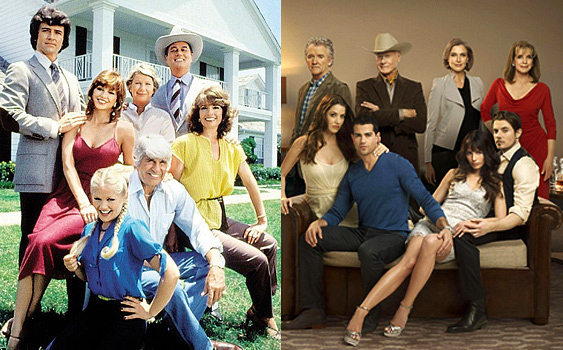
It's not often a classic show returns to TV after being off the air for decades. TVWW is offering a few perspectives on the show, courtesy of contributors Ed Bark and David Sicilia. Also, don't miss Bark's list of 10 things you probably don't know about Dallas
(and yes, we're talking about the show, not the city).The original
Dallas television series (1978-1991) made television — and ratings — history. Its “Who Shot J.R.” episode in 1980 garnered what still ranks as the second largest audience in TV history for a scripted series episode (after the final episode of
M*A*S*H).
Dallas carried the nation from years of diminished expectations into an era of Wall Street excess — the one before the one now! — and American muscularity. In spite of the 1970s energy crisis, Ronald Reagan and George H. W. Bush projected American bravado through the rough-and-tumble 1980s and around the globe.
For its part, the popular prime-time drama about the Ewing oil dynasty projected an image of lavish wealth, domestic turmoil, boundless ambition and ruthless business dealings that — as syndication spread around the world — convinced many foreign viewers that the Texas Ewings were in many ways typical Americans.
When, a decade after the series ended, George H.W. Bush became president, fiction mashed up with fact. The Bush family had become the Bush dynasty, “W” a cowboy president with his six-shooter aimed at Iraq. As in many dynasties, the sons (George W./J.R.) went to excess to surpass the deeds of the fathers (George H.W./Jock Ewing). Dallas spawned a copycat rival glitzy prime-time soap in ABC's Dynasty. Today, George W. Bush spends most of his time on a sprawling ranch in Crawford, Texas, and at his second home — in Dallas.
Dallas was a hit not only for its zeitgeist. The plots, and nearly every character, were deliciously diabolical. Larry Hagman’s J.R. Ewing delivered Machiavellian gems about business and family that, even when cliché (“Keep your friends close and your enemies closer”) were a sweet mix of genuine caricature. The intense family loyalty
and back stabbing, centered especially in the sibling rivalry between J.R. and his brother, Bobby (Patrick Duffy), kept audiences on edge. It was like the Corleone family except on television and in (sort of) legitimate business.
The new series ratchets into the generation of J.R. and Bobby’s young adult sons, John Ross (III) and Christopher, and their significant others. Yet several of the stalwarts from the original are back. Along with some major characters — Hagman, Patrick Duffy as feuding brother Bobby, and Linda Grey as the still-luscious Sue Ellen Ewing — are some lesser returnees: Charlene Tilton as Lucy Ewing and Steve Kanaly as Ray Krebbs.
You’ll get the key elements of the new season within the first few minutes of this Wednesday’s premiere. Bobby has cancer. South Fork is for sale. John Ross, every bit J.R.’s son, hungers for oil riches and the return of Ewing glory. Christopher, Bobby’s adopted son, is developing alternative energy.
I haven’t "spoiled" anything, because even within the first half hour, the plots start twisting and the venom starts spurting just as in the good ole original. By the fourth show, the fight over the Ewing ranch has been layered and litigated so much that neither you nor Bobby Ewing will remember what he had in mind in the first place. Then, lo and behold, another character from the original reappears. I won’t spoil this one. But here’s a hint: He was a weak link then, and he’s a weak link now. Holmes needs his Moriarty.
Well, something had to change in the intervening decades. At first, the idea of a retread about the oil business in our age of hybrid vehicles and e-commerce seemed anachronistic to me. And there are quaint touches, like the original theme song, the '70s-looking graphics, and the suitcases stuffed with cash. But there are flat screens and smart phones, too. And if the Iraq war and four-dollars-a-gallon gasoline taught us anything, it’s that now more than ever, oil is black gold.
It will take time for us to get to know and care about the new generation. Josh Henderson as John Ross is the edgiest. The women are stronger and fuller characters than back in the '80s, and not just the wives of the Ewing boys. Sue Ellen is running for governor!
For my money, Larry Hagman, now 81, still steals the show. His sinister one-liners were never better. “My friends are in the State House. My enemies will be harder to find.” His silver eyebrows point devilishly upward at the ends. The mischievous glint in his eye is undimmed by time. “The courts are for amateurs and the faint of heart. No, this is personal.” Every relationship in his life is fraught — Oedipal struggles with his son, blood feud with his brother — and he thrives on it.
Poor, exasperated, good-intentioned Bobby, still trying to patch things up — except when his big brother pushes his buttons. “I am sick to death of this family devouring itself over money.”
The acting and writing and sheer wickedness of the Dallas reboot is on par with the original. The leap from one series to the next is nearly seamless.
Yet times have changed. Like John Ross’ Southfork oil well, there’s no guarantee this gamble will strike big.
But I’ll be watching.